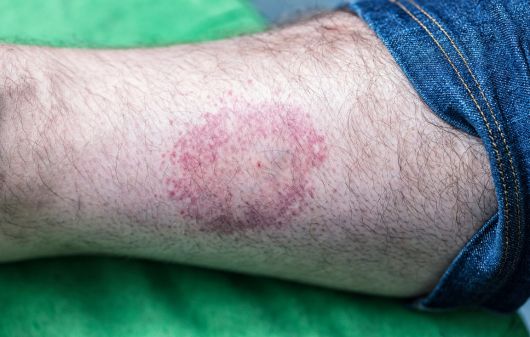Overview
A bullseye rash is commonly linked to Lyme disease, but did you know that not every bullseye bug bite points to Lyme? Other factors, such as spider bites, allergic reactions, or skin infections, can cause a ring bullseye bug bite look alike. For instance, a spider bite bullseye rash is often seen with bites from the brown recluse spider, and a bullseye bruise can develop from certain skin irritations or injuries. While a bull’s eye pattern rash might raise concerns about Lyme disease, it’s important not to jump to conclusions. Many conditions can mimic the look of a Lyme rash, leading to confusion and potentially delaying proper treatment. If you see a bullseye rash, getting medical advice is crucial to determine the exact cause. In our blog, we’ll explore what can cause a bullseye rash if it’s not Lyme disease, what conditions can be mistaken for a Lyme rash, what kind of bug bites leave a bullseye, and how to treat a bullseye rash. Stay tuned to learn how to handle these symptoms effectively and ensure you get the right care.
What can cause a bullseye rash, not lyme?
A bullseye rash is often associated with Lyme disease, but several other conditions can cause a similar appearance without being linked to Lyme.
Here are various causes of a bullseye rash not associated with Lyme disease:
Bullseye Rash Spider Bite
A bullseye rash spider bite, particularly from the brown recluse spider, can create a bullseye appearance. The venom from the bite causes localized tissue damage, leading to a red, inflamed area around the bite with a dark or necrotic center. The body reacts to the venom, forming the classic red ring surrounding the bite, resembling a bullseye. This type of rash is typically painful and can lead to more severe skin damage if untreated. Research

Key symptoms of a brown recluse spider bite:
- Symptoms start 2-6 hours after the bite, with pain and swelling.
- A red blister forms with a "bull's-eye" pattern.
- Necrosis may develop within 12-24 hours, turning the area purple or black.
- Systemic effects like fever appear within 2-3 days but rarely with necrosis.
- Healing can take weeks to months, sometimes requiring skin grafts.
Delaying treatment for spider bite can lead to complications like cellulitis, necrosis, and sepsis. Nip the evil in the bud.
Tick Bullseye Rash, Not Lyme
Ticks are infamous for causing Lyme disease, but not all tick bullseye rash cases are due to Lyme. Sometimes a tick bite can cause an allergic reaction, resulting in a similar-looking erythema migrans rash without infection. Other tick-borne illnesses, such as Southern Tick-Associated Rash Illness (STARI), can also cause a Lyme-like bullseye rash but are not associated with Lyme disease. These conditions may require different treatments, so a proper diagnosis is essential.
Fact: The most common tick bite rash is a solid pink color, more frequent than the bullseye rash, but it appears in only about 50% of Lyme disease cases.
Homogeneous red area or central redness early on, rather than the classic bullseye pattern with central clearing. It typically occurs 3 days after the onset of symptoms.

Key symptoms of a tick bullseye rash
- Low-grade fever
- Headache
- Neck stiffness
- Joint pain (arthralgia)
- Muscle pain (myalgia) or fatigue
Most patients respond well to antibiotic treatment, and many develop IgM or IgG antibodies to B. burgdorferi during recovery.
Why wait for complications when you can get a prophylaxis?
Erythema Multiforme
Erythema multiforme is a hypersensitivity reaction that can occur due to infections, medications, or other triggers. It often presents as a bullseye rash with concentric rings, closely resembling Lyme disease. Unlike erythema migrans rash, which is associated with Lyme, erythema multiforme is typically triggered by infections like herpes simplex virus (HSV) or certain antibiotics. This condition usually resolves on its own but may require treatment if severe.

Key symptoms of Erythema Multiforme
- Starts as small red spots, developing into raised patches.
- Often forms a "target lesion" with a dark red center, pale pink ring, and darker outer ring.
- It may cause mild itching or discomfort.
- Typically fades within 2 to 4 weeks.
- Severe cases may involve large, raw, and painful red areas.
Do not get confused. Get a diagnosis and early treatment of your bull's eye rash now.
Bullseye Bug Bite Not Tick (Insect Allergies)
Other insect bites, such as fleas, mosquitoes, or mites, can cause a bullseye bug bite, which is not a tick bite. In these cases, the body’s immune system may overreact to the bite, forming a circular rash with a central bite area. The reaction is due to the insect’s saliva or venom, triggering an allergic response that can mimic the appearance of a bullseye rash. Below is a wasp bite.

Key symptoms of Bullseye Bug Bite
- Central red spot with surrounding redness, resembling a bullseye.
- Raised, itchy bumps are common.
- Swelling may occur around the bite area.
- Show localized redness and irritation.
- Can be painful or uncomfortable, depending on the insect.
- Blisters or crusting may develop at the bite site.
- Typically resolves within a few days, but itching can persist longer.
Get the best Anti-allergic and topical antibiotic for a quick recovery.
Fungal Infections (Ringworm)
Ringworm is a common fungal infection of the skin that causes red, circular, or bullseye-pattern rashes. Although it is not caused by a bite or tick, it forms a distinctive raised ring around the infected area. This rash can be mistaken for a Lyme-associated erythema migrans rash, but it is fungal and spreads through contact with contaminated surfaces or animals.

Key symptoms of a rash from fungal infections:
- Often round or oval with defined edges, sometimes with a raised border.
- Common, especially as the infection progresses.
- Many fungal rashes, like ringworms, have a red border with a more apparent center, creating a ring-like appearance.
- The affected area may have a dry, flaky texture.
- The rash can gradually enlarge if untreated, affecting surrounding skin areas.
The rash can gradually enlarge if untreated, affecting surrounding skin areas.
Cellulitis
Cellulitis is a bacterial infection of the skin that can occasionally cause a bullseye appearance. It is usually caused by bacteria like Staphylococcus or Streptococcus and results in redness, warmth, and swelling. Sometimes, the infection can present with a bullseye rash, especially if it starts as a localized infection that spreads outward, forming rings. Immediate medical treatment with antibiotics is necessary to prevent the infection from worsening.

Key symptoms of Cellulitis:
- The affected skin appears red, warm to the touch and may feel swollen.
- The area is often swollen and may feel firm or tense.
- The affected area is usually painful, especially when touched.
- Cellulitis often expands quickly if untreated, spreading to nearby skin.
- Systemic symptoms like fever, chills, and fatigue can develop in more severe cases.
Cellulitis can lead to sepsis if not treated timely. Prevention is better than cure.
Autoimmune Diseases
Certain autoimmune conditions, like lupus or vasculitis, can cause bullseye rashes as part of their symptoms. These rashes are often associated with the body’s immune system attacking its tissues, resulting in inflammation and rash patterns that can appear circular or target-like. Managing the underlying autoimmune disorder is crucial in controlling the rash.

Key symptoms of a Vasculitis Rash:
- Often appears as small, round red or purple spots (petechiae) or larger bruise-like patches (purpura).
- The rash may be painful, particularly in more severe cases.
- In some cases, the rash forms raised bumps or nodules on the skin.
- Severe cases may lead to blisters or open sores as blood vessels become damaged.
- It commonly appears on both sides of the body, especially on the lower legs.
- It may be accompanied by systemic symptoms such as fever, fatigue, and muscle pain.
Prevent skin ulceration and necrosis. Get a Doppler ultrasound and treatment.
Medication Reactions
In rare cases, certain medications can cause a bullseye rash as a side effect. This condition is typically part of a drug reaction called Stevens-Johnson syndrome or toxic epidermal necrolysis, which causes severe skin reactions. Medical attention is crucial to prevent more severe reactions if a rash develops after starting a new medication.

Key symptoms of a Medication / Drug rash
- Red, widespread rash: Often appears symmetrically on the body.
- Commonly accompanied by intense itching.
- It can manifest as hives or pinpoint red dots (maculopapular rash).
- Swollen areas, especially on the face or limbs, may occur.
- The rash typically develops within days of starting a new medication.
Noticed a rash after taking medication? Don't wait for it to worsen.
What can be mistaken for Lyme rash?
A Lyme rash, also known as erythema migrans, is often the first sign of Lyme disease, typically presenting as a red bullseye-shaped pattern around the site of a tick bite. However, several skin conditions can be mistaken for this bull’s eye rash, not Lyme. One common mimic is ringworm, a fungal infection that creates a red, circular rash with a clear center, closely resembling a bullseye rash, not Lyme disease.
Pityriasis rosea, a viral skin condition, starts with a single large patch followed by more minor, ring-like spots, which can look like a Lyme rash.
Another potential imitator is a spider bite, such as from the brown recluse, which can develop into a bullseye rash, though it’s not linked to Lyme disease.
Certain bacterial infections, like cellulitis, can also produce red, circular patches of inflamed skin, leading to a bull’s eye rash, not Lyme.
Granuloma annulare, a chronic skin condition that creates raised, red-ringed lesions, may also be confused with a bullseye rash. While these conditions can look similar, they require different treatments, making it essential to consult a doctor if you notice a bullseye rash. By understanding the potential mimics of Lyme disease, you can avoid misdiagnosis and get the right care for your skin condition.
What kind of bug bite leaves a bullseye?
A bullseye rash following a bug bite is commonly associated with Lyme disease, which is transmitted by the bite of an infected black-legged tick (Ixodes scapularis). However, other bug bites can also result in a bullseye rash. One of the most notable is the brown recluse spider bite. This venomous spider releases a toxin that can cause a localized reaction, resulting in a red ring surrounding a central blister or necrotic area, creating a bullseye appearance. The bite may become painful, and the skin around the bite can ulcerate if left untreated.
Flea and mosquito bites can also occasionally cause allergic reactions that manifest as a bullseye rash, although these are less common. The body’s immune response to the insect’s saliva or venom can result in redness and swelling that forms a ring around the bite, mimicking the Lyme-related erythema migrans rash. Research
How to treat bullseye rash?
Treatments for various causes of a bullseye rash are discussed below:
Treatment for Lyme Disease Bullseye Rash
If the bullseye rash is caused by Lyme disease, treatment with antibiotics is essential. Common antibiotics include doxycycline, amoxicillin, or cefuroxime, depending on the patient’s age, medical history, and allergies. Early treatment is crucial to prevent complications like arthritis, heart problems, and neurological issues. If you notice a Lyme disease red circle on skin not ringworm, especially if accompanied by symptoms like fever, fatigue, or joint pain, see a doctor immediately. If the rash appears on the Lyme disease face, it requires urgent medical attention to avoid severe consequences. Research
Treatment for Ringworm Bullseye Rash
A worm bullseye rash not Lyme indicates a fungal infection, such as ringworm. This condition is treated with antifungal medications, which can be applied topically or taken orally for more severe cases. Over-the-counter antifungal creams, such as clotrimazole or terbinafine, are typically effective for mild cases. For more persistent or widespread infections, a doctor may prescribe stronger oral antifungal medications like itraconazole or griseofulvin.
Treatment for Allergic Reactions to Insect Bites
In cases where the bullseye rash results from an allergic reaction to an insect bite, antihistamines like diphenhydramine (Benadryl) or cetirizine (Zyrtec) are used to reduce itching and swelling. For more severe reactions, corticosteroid creams or oral steroids may be prescribed by a doctor to alleviate inflammation.
Treatment for Spider Bite Bullseye Rash
A bullseye rash from a spider bite, such as from a brown recluse, may require more intensive care. Immediate cleaning of the wound, applying a cold compress, and taking over-the-counter pain relief like ibuprofen can help manage symptoms. In more serious cases, where the bite leads to necrotic tissue, medical intervention is required. A doctor may prescribe antibiotics to prevent infection or, in severe cases, perform surgery to remove damaged tissue.
Treatment for Autoimmune-Related Bullseye Rashes
If the bullseye rash is due to an autoimmune disorder, such as erythema multiforme, treatment often includes corticosteroids to reduce inflammation. In some cases, immunosuppressive drugs may be prescribed to control the underlying autoimmune condition. Early diagnosis and treatment by a dermatologist or rheumatologist are important for managing these conditions.
When should I consult a doctor?
You should consult a doctor if you experience any of the following:
- Bullseye rash appears, especially after a tick or insect bite, as it may indicate Lyme disease or another serious condition.
- The rash expands or changes in appearance, such as forming a Lyme disease red circle on the skin not ringworm.
- Accompanying symptoms like fever, fatigue, headaches, or joint pain develop, which are signs of a possible infection.
- The bullseye rash appears on your face or near sensitive areas like the eyes, potentially indicating severe complications.
- The rash persists or worsens despite over-the-counter treatments.
- The bite area becomes swollen, painful, or shows signs of infection (e.g., pus, warmth).
- You experience difficulty breathing, dizziness, or swelling in other parts of your body, as these could signal a severe allergic reaction.
- If the rash is suspected to be due to an autoimmune condition or another systemic illness.
- The rash follows a spider bite or you suspect a brown recluse bite, which can cause tissue damage.
FAQs about the bullseye rash not lyme
The duration of a bullseye rash depends on its cause. For Lyme disease, it typically lasts for a few weeks, but with antibiotic treatment, it may fade faster. If caused by a spider bite or allergic reaction, the rash can last a few days to weeks, depending on severity and treatment.
Yes, a bullseye rash can grow in size, especially if it’s related to Lyme disease. It often starts small and expands over days or weeks, sometimes reaching up to 12 inches in diameter. If the rash continues to enlarge, it’s important to consult a doctor for evaluation.







